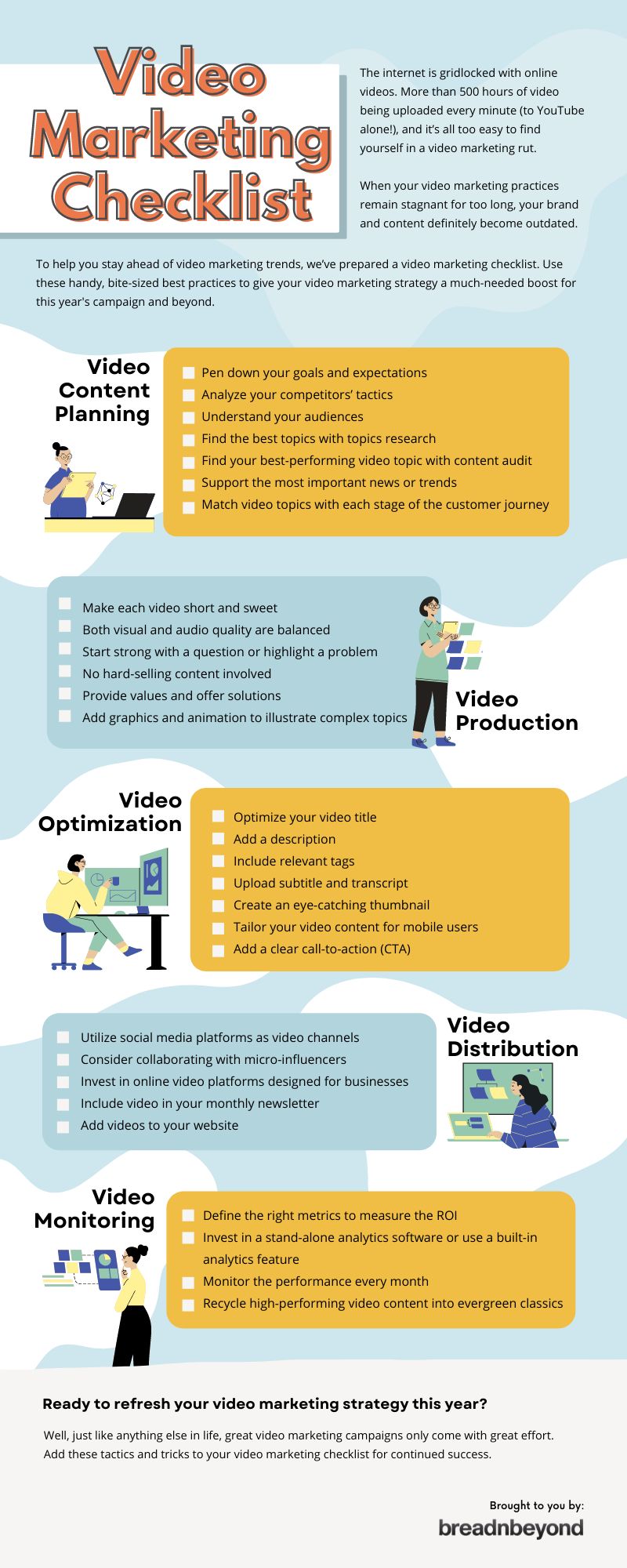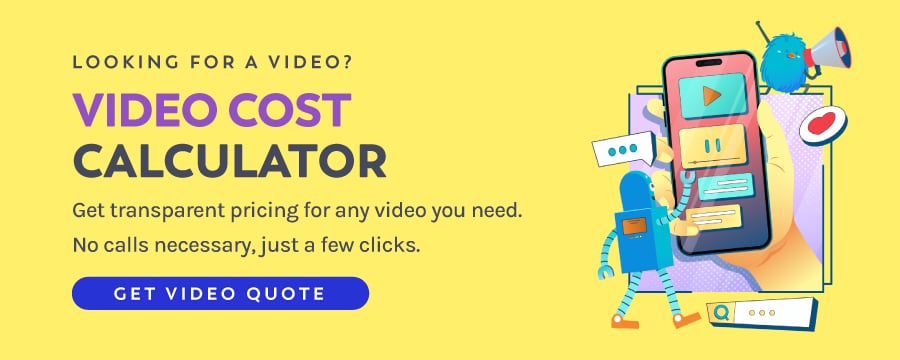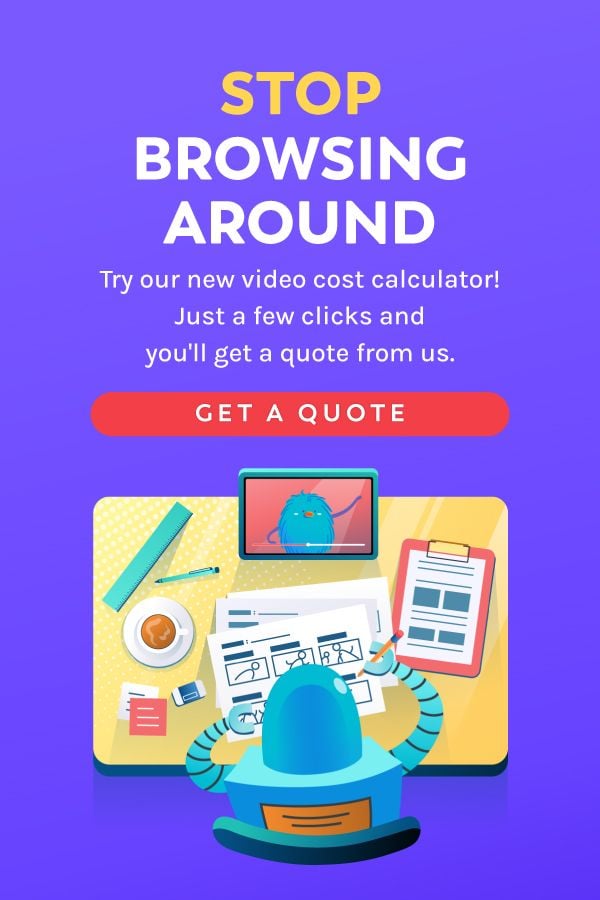Table of Contents ×
- 1 A Sneak Peek into Video Marketing Field
- 2 Video Marketing Checklist
- 3 The Key to a Winning Video Marketing Strategy
- 3.1 1. How Do I Plan My Video Content?
- 3.1.1 Pen down goals and expectations
- 3.1.2 Analyze competitors tactics
- 3.1.3 Understand your audiences
- 3.1.4 Find the best topics with topic research
- 3.1.5 Find your best-performing video topic with a content audit
- 3.1.6 Support the most important news or trends
- 3.1.7 Match video topics with each stage of the customer journey
- 3.2 2. What Should I Do in the Video Production Process?
- 3.3 3. How Do I Optimize My Video?
- 3.4 4. Where Can I Distribute My Video?
- 3.5 5. How Do I Monitor The Video?
- 3.1 1. How Do I Plan My Video Content?
- 4 How to Use the Video Marketing Checklist?
Are you wondering if you are missing something in your video marketing strategy?
You may have created marketing videos constantly, have shared them on all of your social media regularly, and even added them to your homepage.
But, still, you don’t get all those significant benefits your fellow marketers have been talking about.
“Is video marketing only a passing marketing fad, then? Or all those impacts are just a myth?!” you begin to contemplate.
Well, what if you actually missed something in the process?
After all, a winning video marketing strategy is so much more than creating videos and making them available on the internet.
That’s why we created the complete video marketing checklist for you.
The checklist includes all the important tasks you need to complete to ensure that you are taking full advantage of video marketing so you can find some missing pieces of your video marketing puzzle.
If you want to unlock the full potential of your video marketing strategy, you’ll love this list.
A Sneak Peek into Video Marketing Field
Let’s kick things off by taking a look at the most important video marketing statistics.
These staggering numbers (collected from surveys and research) show that video marketing is here to stay and can be a powerful tool if done correctly.
- By 2023, online videos will make up more than 82% of all consumer internet traffic.
- Globally, 25% of internet users watch online videos every single day.
- At least 86% of businesses use video as a marketing tool.
- Nearly 61% of companies say that video content is a major part of their marketing plan.
- The most common types of marketing videos created are explainers (73%), social media videos (67%), presentations (51%), sales videos (41%), and video ads (41%).
- YouTube remains the most widely used video platform among video marketers.
- 68% of people will watch a full video if it’s a minute long or less.
- More than 1/3 of all online activity is spent watching video.
Video Marketing Checklist
Here comes the checklist! From content planning to video monitoring, this handy checklist will help you understand what you should bring to the table.
Also, each list item has a breakdown (in the next section) to help you accomplish the task.

<div style="clear:both"><a href="https://breadnbeyond.com/video-marketing/checklist/" target="_blank" rel="noopener"><img src="https://breadnbeyond.com/wp-content/uploads/2021/11/Video-Marketing-Checklist-Infographic.jpg" class="img-embed" title="The Complete Video Marketing Checklist Ever!" alt="The Complete Video Marketing Checklist Ever!" width="800" height="2000" border="0"/></a></div><div>Courtesy of: <a href="https://breadnbeyond.com" target="_blank" rel="noopener">Breadnbeyond</a></div>The Key to a Winning Video Marketing Strategy
Now that you’ve got the list, it’s time to break down each point so you have a solid grasp of what you should do to accomplish them.
1. How Do I Plan My Video Content?
A successful video marketing campaign always starts with well-thought-out preparation. Here are some points you should follow to make sure you come up with the right video marketing plan.
Pen down goals and expectations
Clear objectives will guide your video-making process. If you know what you are creating all those marketing videos for, you can come up with a relevant strategy that will support it in achieving those goals.
Make sure all those goals are reachable and measurable.
Analyze competitors tactics
Your competitors can be your best teachers. By keeping an eye on them, you are effectively increasing your video marketing capabilities.
Find out how they use their videos, how their audiences interact with them, what they’re lacking, and how you can do better.
Understand your audiences
Who do you create those marketing videos for? Once you know your audiences– their demographics, interests, preferences, pain points, and even values, it would be much easier for you to craft relevant content that appeals to them.
Find the best topics with topic research
The topic you use in your marketing videos is probably the reason why your audiences want to engage with it.
It’s crucial to conduct research to find out what specific topics will resonate best with your audiences.
Find your best-performing video topic with a content audit
You can find your high-performing video topic using content audit.
See which type of content on your website, blog, or social media has high engagement from your audiences. And make a fresh, new marketing video out of it.
Support the most important news or trends
To come up with relevant video content, you need to constantly stay up to date with the latest trends in the digital field.
Ask yourself, “What has everyone been talking about lately?”. In this case, you can use social media monitoring tools.
Match video topics with each stage of the customer journey
Each video has its own way of helping you achieve a specific goal. Some of them are best to attract audiences’ attention, while others do a good job in generating trust.
That’s why it’s always better to create a video for each stage of the customer journey.

2. What Should I Do in the Video Production Process?
With some outstanding and creative magic in the production process, your marketing videos will not only entertain; they will inform, enlighten, and finally be intrigued.
Make each video short and sweet
When it comes to marketing videos, less is always more. The rule of thumb is to keep most videos under two minutes. However, you also need to consider the platform or channel you’re using.
Both visual and audio quality are balanced
Remember that videos are a combination of both visual and audio elements. That means you need to make sure that those two elements are well-balanced.
All those stunning visuals should be complemented by crystal-clear background music, sound effects, or voice-over.
Start strong with a question or highlight a problem
The adage “save the last for the best” doesn’t apply to video marketing. You have to start your videos with catchy, attention-grabbing lines to perk your audience’s ears.
You can start by asking questions, highlighting pain points, or thought-provoking facts.
No hard-selling content involved
No one wants to be a target customer. It means that if you create a video just to brag about your awesome features, it won’t get you anywhere.
Avoid the hard sell by continuing to be informative and educational.
Provide values and offer solutions
Your audiences don’t care about what you sell through your videos. They only care about how it will benefit them.
Focus on the solution you offer; and how your products or services will make your audience’s lives better and easier.
Add graphics and animation to illustrate complex topics
When you have complex topics to get across, consider adding graphics and animation. Not only will they convey your messages better, but they will also help your audiences enjoy the explanation.
3. How Do I Optimize My Video?
If your content isn’t showing up in Google and video platform searches, all the effort spent on video content planning and production can be a huge waste of money and time.
Relying on virality alone as a tactic to get into the spotlight is not really a sustainable solution.
Optimize your video title
When you upload videos on a video-sharing platform like YouTube or Vimeo, make sure you use keyword-based titles so that they can rank on the platform or even search engines.
You can use tools like vidIQ, TubeBuddy, etc., which allow you to identify ideal keywords for your video title
Add a description
YouTube and other video-sharing platforms use your description to understand the content (and context) of your marketing video content.
Put another way: a well-optimized description can boost your video’s rankings in search results.
Include relevant tags
#Hashtags can lead people to your video from other videos that use the same hashtag. Also, relevant hashtags help video-sharing platforms better understand your video content, so they will show your video to relevant audiences.
Upload a subtitle and transcript
Launching a video that has either captions or subtitles enables video-sharing platforms to understand what you said, therefore the higher your video rank on the platform.
Besides, you can also expand your reach; your audience who have hearing difficulties, mobile users that play the video with the sound off, and non-native speakers can still enjoy your video and receive your message.
Create an eye-catching thumbnail
Along with the title, your thumbnail is the first thing that your audiences see when they find your video. This is why you need to make sure that you create them as eye-catching as possible.
You can use easy-to-use graphic design tools like Canva, PicMaker, Crello, etc.
Tailor your content for mobile users
Videos are 1.5 times more likely to be watched through mobile devices. The smaller the screen, the more the viewer will have to squint to see the information.
Make sure your text or other visual elements you use on the video fit into those mobile devices’ screens.
Add a clear call-to-action (CTA)
Creating a marketing video without a clear CTA is like fishing without a hook. Your audiences have no clue what they are supposed to do next after watching the video.
Don’t forget to communicate the purpose of your video so they can do your desired actions, such as visiting your website, following your social media profiles, downloading ebooks, etc.
4. Where Can I Distribute My Video?
Creating a marketing video is one thing. Making sure that it gets the limelight it deserves is another.
Video distributions have to be done on different platforms to ensure that the message you intend to pass reaches the largest number of people in the target audience.
Utilize social media platforms as video channels
With billions of active users worldwide, social media can be a potential platform to distribute your videos. That said, it’s important to understand in which social platform your target audiences spend most of their time online. It helps you to create a more efficient video marketing strategy.
Consider collaborating with micro-influencers
If you have an extra budget for the campaign, consider working with influencers to give your marketing videos the exposure it deserves.
It doesn’t have to be mega or macro-influencer. Even micro-influencers have massive, more relevant followers to help you gain more awareness.
Invest in online video platforms designed for business
Utilizing online marketing video platforms such as Wistia, Vidyard, Brightcove, etc., helps you reach potential audiences who are interested in your content.
They provide you with features that are designed to fulfill your needs when it comes to video marketing, from audience targeting to reports and analytics.
Include a video in your monthly newsletter
Email newsletters can also be a great way to distribute your marketing videos while nurturing your leads at the same time. Emails with videos are proven to increase open rates and decrease unsubscribe rates.
Add videos on your website
Not only does well-optimized videos increase your website rank on search engine result pages, but they also help audiences understand more about what you do and how you can be a good solution for them in a matter of minutes.
Place your videos on your homepage, landing pages, About Us page, etc.
5. How Do I Monitor The Video?
In practice, video marketing is data-driven, so you’ll have to monitor the videos and understand how well they’re performing. This way, you can determine the success of your campaign.
Define the right metrics to measure the ROI
It’s essential to choose the right metrics that matter most for your video campaigns. It helps you to identify which videos work and whether they help to achieve your goals.
For instance, if your goal is to strengthen brand awareness, you need to pay closer attention to views and shares, and measure the ROI.
Invest in a stand-alone analytics software or use a built-in analytics feature
Understanding your video analytics gives you the power to improve.
You can use a video analytics tool that’ll enable you to transform your communication and drive more revenue through video marketing, such as Vidyard, Videooly, Cincopa, Vidalytics, etc.
Track the performance every month
By tracking your video marketing regularly, you have insights into how your videos are actually performing.
You’ll know if there’s room for improvement immediately, so you can adjust your video marketing campaign to fit your audience’s viewing needs better.
Recycle high-performing video content into evergreen classics
Coming up with new, fresh marketing content every month or even a week is hard work. You can recycle your best-performing videos into blog posts, e-books, or infographics.
How to Use the Video Marketing Checklist?
There’s no such thing as a one-size-fits-all checklist in video marketing, or even digital marketing in general.
So, the best way to use this list is to go through the items one by one and find out which ones you need to add to your video marketing strategy. Only apply the best practices to your strategy that align with your business goals.
Remember that online businesses have different goals, and not all items may apply to your case.
Breadnbeyond can help you with video content planning and production. Our professionally-made explainer videos help you perfect your video marketing strategy. Check our packages and get a FREE consultation by clicking on the banner below!


